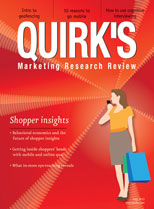Editor's note: Lyle Durbin is CEO of ReconMR, an Austin, Texas, research company. He can be reached at lyle.durbin@reconmr.com or at 877-732-6667. This article appeared in the July 22, 2013, edition of Quirk's e-newsletter.
For quite some time, public opinion researchers have relied heavily on the telephone to reach random, unbiased samples that were projectable to any given population. Initially, this was easily achieved with virtually all households containing a telephone line via a landline that was answered frequently. But with Caller ID and the pervasiveness of cell phones, the landline is no longer the gold standard in gen-pop sampling.
Randomly-generated telephone samples of dedicated wireless numbers can augment a landline study but provide little in the way of accurately targeting smaller geographies and the low efficiency of these samples leads to higher project costs. This has left many researchers struggling to find the appropriate methodology to confidently sample general market populations.
Solve the sampling dilemma
"Enhanced" U.S. cell phone samples offer the potential to solve the random sampling dilemma. Utilizing the telephone survey center of ReconMR's sister company, CRI, we conducted a self-funded research study to test the efficiency, representation and any potential bias from this new telephone sample. As part of a larger study exploring technology and media usage, 600 total respondents were interviewed across the state of Texas, with 200 surveys completed from each of three distinct telephone samples - enhanced cell phone, RDD cell phone and listed household landline. Scientific Telephone Samples provided all of the telephone numbers. Quotas were imposed to ensure each sample type contained proportionate geographic representation among the four largest Texas metropolitan areas (Austin, Dallas-Fort Worth, Houston and San Antonio). Because the landline sample offers opportunity for multiple household members to qualify for the study, quotas were imposed upon this sample to ensure an even gender distribution. No other quotas were implemented.
Very promising
The testing provided very promising results. Dramatic efficiency gains were observed with a much higher response rate coupled with fewer non-working numbers. This led to almost half as many telephone numbers required to complete the same number of interviews when utilizing the enhanced cell phone list. Even with the greater cost associated with this type of list, the increased efficiency of the sample leads to total fielding costs that are 20-30 percent lower than landline or RDD cell phone samples.
While lower costs are always welcome, they should not come at the sacrifice of proper representation. To examine this, ReconMR compared key demographics achieved from the three sample sources. With regard to age and race, both cell phone samples achieved samples much more proportionate to the general population than the landline sample. While the Census reports 34 percent of the adult population to be under the age of 35, the landline sample only produced 8.5 percent within this age category, while the enhanced cell phone sample achieved 31 percent and the RDD cell phone sample achieved 41 percent. Most importantly, very few differences were noted in both the makeup and attitudes of the enhanced cell phone sample and the RDD cell phone sample. With the disproportionate demographics within the landline sample, many differences were noted between this sample and both cell phone samples.
Much more representative
The ultimate goal of any research is to obtain a sample that proportionately represents the entire study universe, providing data that is projectable to the population. While the enhanced cell phone sample provides a representative, cost-effective sample list, it is important to recognize the potential groups that would not be included in this sample. Obviously, there still remains a significant and relevant population that does not have a cell phone.
Additionally, there exists some evidence from the study that respondents with lower income and lower education appear to have a lower likelihood of inclusion within the new enhanced cell phone sample. However, when used in conjunction with the traditional telephone sources, this new sample appears to reach important audiences that, without such a sample, would potentially be left out.
